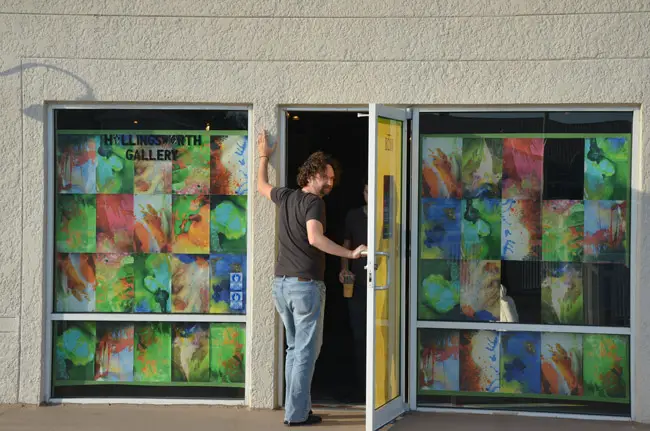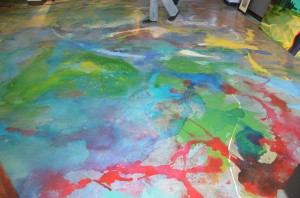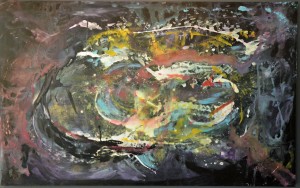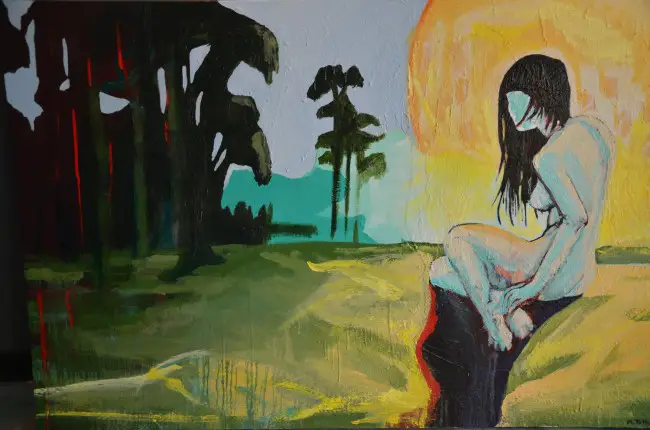
Around the world, people are preparing for impending doom. They are buying candles, generators, canned foods, weapons and even underground bunkers, on the assumption that the Maya version of Apocalypse Now may be for real.
In Palm Coast, JJ Graham is preparing as well – for an art show.
“The idea for the show is that we should focus on why the world shouldn’t end,” said Graham, owner of the Hollingsworth Gallery in City Market Place. “It’s a positive thing.”
Entitled “I Decided Not to End the World,” the show opens Friday, Dec. 21, the date the ancient Mayan calendar ends, signaling to some the end of the world. On one hand predictions of the end of the world as nutty as they come. In Maya lore, Friday brings the end of a 5,125-year cycle known as the Long Count in the Mayan calendar. It’s a mythically fertile idea, but it has no more bearing on reality than Bishop Ussher’s dating of the beginning of time to Oct. 23, 4004 bc. Mayan civilization, brilliant at many things–including language, architecture and even math–and brutal at many others, was not much better than Republican pollsters when it came to predicting events in 2012.
On the other hand, and as such predictions tend to do, more than a few people have taken the doomsaying seriously enough to generate a little boomlet for priests’ and shrinks’ services and survivalist stores. The government in Russia went as far as having its minister of emergency situations declare that he had access to “methods of monitoring what is occurring on the planet Earth,” and that he could assure citizens that the world was not going to end, at least not this Dec. 21. American retailers are just as certain: the world could not possibly end before the end of the Christmas shopping season.
Besides, Graham is planning an encore for his show in a month, giving it a full six-week run in all. The end of the world can wait. Assuming it’s still around by 6 p.m. Friday evening, the show will feature about 45 pieces by artists and local children. The “I” in the show title refers to the “omnipotent being” who will look down on the art and see it as one reason to let the world go on, Graham (who exercises his own form of omnipotence at Hollingsworth) said.
To Graham, in other words, any chatter about the end of the world is an excuse to remake it in art’s, if not his (rather than His), image.

This big bang of a floor seems as important to the show as the pieces surrounding it, and in some cases exceeds the beauty of the pieces surrounding it. Graham turned the floor into a mosaic of pictures that he then used to plaster the glass walls of his gallery, so no one could peer inside for the weeks it took him top prepare “I Decided Not to End the World.” The effect was at once to hide the show while hinting at giving it away, though the spoiler doesn’t take effect until you step inside: Graham hid his show’s emergence with its own substance, the way the universe hides its nurseries with dark matter. It would be a shame if the plastered photographs came down, as planned: they’ve become integral to the show.
And they stand there in perfect echo of what is sure to be the centerpiece of the show: The 12 portraits of young art students, shot from above as they lie on the big bang floor, staring upward with various expressions of expectancy and utter vulnerability. The children are not yet teenagers. They’re barely out of their own big bang. But they’re beginning to see the possibilities, and discover their place in it: no longer at the center of it (placing twelve such children in a row makes the point quite starkly), but no less crucial to its center. Children are the definition of the future, the anti-thesis of the end of the world, at least when left alone by those who would end it (cue the Newtown massacre). The installation creates that feeling. The children might as well be adrift in their universe, as well they should be, but they’re looking for their place. The work is by Petra Iston, a graphic art and design teacher at Hollingsworth (and Graham’s girlfriend).

Most of the pieces in the show are abstract and full of color — “charged,” as Graham says. A piece by Jean Banas entitled “Warsaw 1939” depicts the beginning of World War II. In a description of the piece, Banas says “It is my symbol of human perseverance and hope, which overcame the horrors of war and evil.”
The show will feature art pieces by the art students, including a boat-like vessel hanging from the ceiling that they will fill with objects representing those expectations. It’s already beginning to fill up with poems, drawings, stories, pictures. By the time the show’s encore rolls around in a month, Graham hopes the canoe, which he made of rabbit-proof fence wire before turning it over to his students to complete, will be filled.
Graham is optimistic that the world will still be around for the complete run of the show. As a young boy and the son of a Pentecostal preacher, he had no reason to doubt the end of the world was imminent, particularly one morning when he had a lax babysitter. “I was around 5 and I woke up and no one was there,” Graham said. “I thought the rapture had happened and everyone else was in heaven, that I was left behind because I was bad. Turns out my uncle was supposed to be watching me, but he left.” Since then, Graham has left behind the belief the world will come to a horrific end, but he has developed a respect for the ancient Mayans.
Graham created the show to give the more uplifting side of doom a little breathing room, last week’s shooting at Sandy Hook Elementary School in Connecticut has made him look at the serious side of it. “Kids need a reason to live, to go on,” he said. “They need more positives in their lives.” That goes for 20-year-old Adam Lanza, the shooter at Sandy Hook, Graham said.
“One can only imagine if someone had put a brush in that kid’s hand, taught him to be creative — things may have been different,” he said. “We should see this as a beginning, an opportunity. Not an end.”
Then again, art is not necessarily the great palliative it is often made to be. More than a few death-camp commanders left their day’s exterminations to have dinner with the family and weep to a little Beethoven before bedtime. And those same commanders’ fuhrer was quite adept with the brush. Thankfully, their world did end, if a few years too late.
![]()






























Leave a Reply